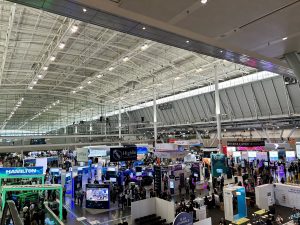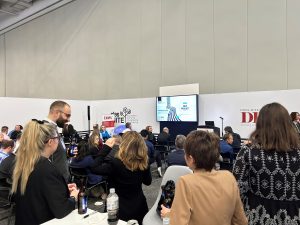SLAS2024: conference report

The Society for Laboratory Automation and Screening (SLAS; IL, USA) International Conference and Exhibition returned to Boston this year, taking place 3-7 February. Fulfilling its tagline, ‘innovation at every turn’, SLAS delivered record-breaking numbers, with over 7,500 attendees and 400 exhibitors braving the sub-zero temperatures to explore cutting-edge innovations taking place across the life science and technology sectors.
Small molecules making big changes
Opening the conference was Juliet Williams of Kymera Therapeutics (MA, USA), who delivered an insightful keynote on the advantages of small molecule degraders as powerful therapeutic tools. Her talk, ‘Solving Big Problems with Small Molecule Degraders’, explored successes in the field of targeted protein degradation (TPD) relative to other small molecule therapeutics in areas such as immunology and oncology. Williams discussed KT-253, a highly potent and selective degrader that targets MDM2, a regulator of the tumor suppressor p53, demonstrating Kymera’s progress in the clinic.
Talk highlights – Day 1
CAR-T cell therapy has emerged as a powerful tool for treating many challenging indications, particularly within oncology. However, CAR-T and other next-generation therapies often struggle to reach the clinic due in part to a lack of applicable animal models. As part of the session ‘Advanced Imaging and High Content Assays’, Chao Ma of New York University (NY, USA) described a solution to this issue in the form of 3D microfluidic ‘organ-on-a-chip’ models. Ma introduced a ‘leukemia-on-a-chip’ model and how it effectively captured several critical datapoints not readily obtainable through conventional in vitro or in vivo models, and how it can model different clinical outcomes. The talk outlined the transformative impact that organ-on-a-chip is poised to have within the drug discovery landscape, particularly for innovative new drug modalities.

A packed exhibition floor at SLAS2024
In the spirit of SLAS’ mission to unite great minds, Douglas Ross-Thriepland (AstraZeneca, Cambridge, UK) discussed the power of effective partnerships in his talk ‘The Joint AstraZeneca – Cancer Research Horizons Functional Genomics Centre (FGC): A pioneering partnership driving oncology target discovery using pooled CRISPR screening’. The joint venture began in 2019 in order to address the growing disconnect between therapeutic discovery and clinical success, with the ultimate goal to accelerate the development of life-changing medicines for patients with cancer. Since its inception, the center has completed 547 CRISPR screens across 78 projects and 153 cell models and has streamlined their access to CRUK’s academic network. Douglass described how the center has facilitated the development of optimized, small genome-wide CRISPR libraries that provide a more sustainable, cost-effective and faster solution to standard CRISPR screens.
Rounding off day 1, we stopped by the ‘Expanding Applications for Omics Modalities’ session, where Catherine Brownstein of Boston Children’s Hospital (Boston, MA) discussed multi-omic approaches to diagnosing genetic disease. Catherine presented ‘long-read sequencing’ (LRS) as a more effective alternative to conventional next-generation sequencing (NGS)-based diagnostics – a method that leaves over two-thirds of patients without a diagnosis. She described a study that used several LRS methods as part of a comprehensive multi-omic approach for three families, resulting in causal variant identification for two, and the elimination of several conditions for the third. Catherine’s fascinating talk highlighted important diagnostic considerations and demonstrated how the initial upfront investment in a multi-omic approach provides long-term benefits such as preventing misdiagnosis and improving patient wellbeing.
Talk highlights – Day 2
Kicking off our second day, we joined the session ‘Screening with Higher Throughput Multi-omic Assays: Enabling More Disease Relevance in Early Drug Discovery’. Focussed on multi-omic approaches to improve the early drug discovery pipeline and maximize the chances of clinical success, Andreas Hock (AstraZeneca), described a strategy called high dimensional experimental design (HDED) to deliver faster results during drug discovery. Contrary to standard experimental design, which is often very rigid, only changing one variable at a time, HDED uses cutting-edge software to design many experiments in tandem that can explore all eventualities and variables. It leverages advancements in throughput to vastly improve speeds at which drug discovery targets can be interrogated and presents a solution that could transform the way we look at drug discovery.
Antibody-drug conjugates (ADCs) are an interesting class of therapeutics that use antibodies to specifically target a therapeutic to a cell type or tissue. Particularly effective against solid tumors, with six agents having currently been granted FDA approval. As part of the ‘Next-Generation Protein Therapeutics’ session, Greg Thurber (University of Michigan, MI, USA) discussed this class of therapeutics, as well as the use of engineered high avidity, low affinity (HALA) antibodies to improve ADC delivery into tumors. Thurber further explained the uses of HALAs during ADC therapy, including how these antibodies could be applied to fine tune ADC delivery to multiple tumors within a single patient.
Talk highlights – Day 3
Stepping slightly away from the scientific topics to start our final day at the conference, ‘DEI in the Lab – Conversations Beyond Hiring’ focussed on diversity, equity and inclusion (DEI) initiatives beyond the hiring process. Panelists included Marilee Lloyd (HED, MI, USA), Brandon Miller (Clarkston Consulting, NC, USA), Ramisa Fariha (Brown University, RI, USA) and Colin Cox (Hexagon Bio, CA, USA), each an expert in the DEI space. The session explored ways in which employers and employees can help individuals from all demographics to thrive and areas where DEI initiatives are currently lacking, and how, by addressing these shortfalls, companies can improve employee retention and support fair and equal opportunities.
Spatial omics is a revolutionary field of work, combining sequencing and other genetic data with imaging to observe genetic data within the context of the physical cell, providing key information on cell–cell interactions. The ‘Spatial omics technologies’ session opened with a talk from Yanxiang Deng (University of Pennsylvania, PA, USA). After providing a detailed overview of the field, Deng introduced a new technology platform called DBiT-seq (microfluidic Deterministic Barcoding in Tissue for spatial multi-omics sequencing). The microfluidics-based system uses patterns of oligonucleotide ‘barcodes’ positioned in a grid over the tissue of interest, a unique strategy that allows for precision spatial profiling of the epigenome that could have exciting implications for disease modeling and therapeutic development. Following Deng, Colin Ng (AtlasXomics, New Haven, CT)’s talk, ‘Improved, high-throughput spatial epigenomic mapping of multiple tissue types at the cellular level’ introduced a further iteration of the DBiT-seq system, called Portal96, which features increased resolution and is able to map chromatin accessibility and histone modifications at the cellular level. The talk concluded with a look to the future, and the impact these technologies could have on emerging multi-omic applications.
Awarding Innovation
Alongside the talks, workshops and exhibitions, SLAS2024 hosted a range of awards to recognize the very best achievements and technologies represented throughout the week.

The New Product Award presentation, taking place in the SLAS Ignite Theater
Day two saw the first tranche of SLAS’ awards, with the announcement of both the New Product Award and the Ignite Award. Designed specifically for start-ups, the Ignite award was chosen from 16 companies participating in ‘Innovation AveNEW’, an area of the exhibition floor reserved exclusively for start-ups and emerging companies. Taking home this year’s award was Depixus (Paris, France) for its MAGNA™ technology – a unique form of magnetic force spectroscopy that enables insights into molecular interactions within the genome. The award also coincided with the unveiling of the Company’s new MAGNA One™ instrument.
The New Product Award was open to exhibitors commercially launching new products within a 90 day window either side of the conference. The judging panel presented three awards, granting BlueCatBio (NH, USA), CytoTronics (MA, USA) and Liquimetrix GmbH (Esslingen, Germany) use of the organization’s prestigious New Product Award designation for 12 months.
Concluding the week was the SLAS Innovation Award, the Society’s renowned award that recognizes the most exceptional podium talk presented during the conference. Sponsors HighRes Biosolutions (Beverly, MA) presented this year’s award to the University of Illinois’ (Champaign, IL) Jongwon Lim, for his talk on ‘Rapid and Ultra-Sensitive Identification of Pathogenic DNA in Blood using a Novel Blood Drying Technique.’
On the exhibition floor
The conference center hosted over 400 exhibitors throughout the week, each showcasing their unique and transformative solutions to leverage the power of technology to accelerate scientific discovery. With such a broad range of exhibitors spanning the length and bredth of the life sciences; from lab consumables to robotics, and disease modeling to microscopy, delegates had plenty to discover across the 3 day exhibition.
Cellular analysis is a critical aspect of almost any preclinical workflow. Presenting its newest solution to real-time analysis of live-cell cultures was Yokogawa, who showcased the CellVoyager™ High-Content Analysis CQ3000 system. Leveraging Yokogawa’s expertise in precision imaging, the CQ3000 is specifically designed to capture high-quality, high-speed 3D images of live cell cultures. Also on the exhibition floor, it was great to catch up with Bio-Rad (Hercules, CA), whose booth featured the ZE5 Cell Analyzer – a flexible solution for flow cytometry automation designed to suit a wide range of experimental complexities and throughput requirements. Also making a big splash in cell analysis automation was ARRALYZE (Garbsen, Germany), with the launch of CellShepherd®, a fully autonomous single-cell platform that enables real-time monitoring of functional assays and deeper insights into experiment kinetics.
The AI ‘revolution’ has brought the power of software to accelerate life science workflows back into sharp focus in recent years. Leveraging the power of AI, Xavo (Bayreuth, Germany), provides software packages that use machine learning algorithms to optimize existing lab infrastructure and improve throughput and safety. We also caught up with Aspen Biosciences (CA, USA), a life science software company with a range of products supporting drug discovery, cancer research and diagnostics, who introduced its software platform, Pipeline, which provides users with a detailed overview of data including program progress, potential impediments, resource allocation, and financial oversight. New product announcements continued with Retisoft (ON, USA), who demonstrated the next iteration of the Company’s Genera software designed to accelerate and simplify lab automation.
Microfluidics was a major focus amongst the exhibitors due to its cost-effectiveness and ability to significantly improve throughput. Sphere Fluidics (Cambridge, UK), guided us through the Company’s revolutionary picodroplet technology; used to power its microfluidic platforms that enabe large-scale experiments at the single-cell level. In this way, the Company is enabling scientists to examine a greater number of cells – and isolate the most valuable ones – faster than ever before, accelerating the early selection of superior candidate cells and reducing overall project timelines from months to weeks, whilst reducing effort and cost. We also got the opportunity to catch up with Arrayjet (Edinburgh, UK), the inventors of inkjet microarray printing and a leading provider of flexible microarray, biochip and microfluidic solutions. The Company’s patented inkjet technology delivers fast, flexible, high-quality, contactless bioprinting, to power life science, diagnostic and drug discovery workflows worldwide.
The SLAS2024 exhibition floor was home to a huge range of companies providing innovative solutions and technologies to support and accelerate the world of drug discovery. Stem cell specialists, Axol Bioscience (Cambridge, UK) and Bit.Bio (Cambridge, UK) provide uniquely programmed, induced pluripotent stem cell (iPSC)-derived cells for drug discovery. Axol’s range of over 70 fully characterized cell lines, called axoLines™ enable companies to access human-relevant data for a wide array of cell types. Bit.bio’s opti-ox™ (optimized inducible overexpression) system gives users the capability to accurately reprogram large cultures of iPSCs into differentiated cell types quickly and efficiently. Empowering a central process to drug discovery, we met up with Nuclera (Cambridge, UK) and Omega Bio-Tek (Norcross, GA), whose technology platforms aim to simplify nucleic acid and protein purification and characterization. Nuclera’s eProtein Discovery™ system provides rapid protein screens, optimizing both expression and purification, as well as supporting effective scale-up of protein purification. At Omega Bio-Tek’s booth, we were introduced to the Company’s new MagBinder® Fit24 system, a nucleic acid purification system that utilizes magnetic rods to efficiently extract nucleic acids from a range of primary human samples. Moving more into the services sector, Metrion Biosciences (Cambridge, UK), a leading ion channel CRO and drug discovery company, shared further insights into its ion channel screening technology, which delivers fast, accurate data on targets for neuroscience and cardiac drug discovery.
The event floor hosted several companies offering solutions and technologies to support healthcare and clinical labs. One of these companies, Veranex (Raleigh, NC), offers a complete end-to-end suite of services to support medtech companies in developing cutting-edge new products from concept through to commercialization. We also met the team at Tecan (Männedorf, Switzerland), who were showcasing several new innovations at their booth, designed to deliver complete workflow solutions to support liquid biopsy, 3D cell biology and proteomics. The new solutions on display included LabNavigator™ and Next-Gen Instrospect™, tools aimed at furthering lab productivity through digitization.
Concluding remarks
With 2024 setting new records for event attendance, the SLAS’s flagship event remains one of the key global leaders in life science conferences. Beyond just an exhibition, SLAS2024 offered exceptional presentations, educational workshops, posters and awards that attracted attendees from industry, academia and governance – it is certainly an event not to be missed. We’re very much looking forward to SLAS2025 in San Diego, California next year and hope to see you there!
For more information on all SLAS events, including SLAS Europe, taking place 27-29 May in Barcelona, visit their website here.